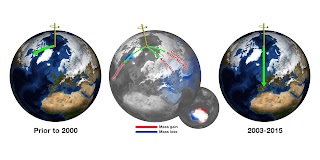 |
| Image Source: Scientific American |
Topics: Climate Change, Global Warming, Greenhouse Gases
Perhaps the lawsuit in Eugene, Oregon will start a trend. It's apparent our elected officials aren't concerned even with their own personal posterity; just the next election cycle: just getting reelected. Two liturgical quotes come to mind:
"The meek shall inherit the earth" (Matt 5:5) and "a child shall lead them" (Isa 11:6). For the sake of the human species, we can all only hope so.
The north pole is on the run. Although it can drift as much as 10 meters across a century, sometimes returning to near its origin, it has recently taken a sharp turn to the east. Climate change is the likely culprit, yet scientists are debating how much melting ice or changing rain patterns affect the pole’s wanderlust.
The geographical poles—the north and south tips of the axis that the Earth spins around—wobble over time due to small variations in the sun’s and moon’s pulls, and potentially to motion in Earth’s core and mantle. But changes on the planet’s surface can alter the poles, too. They wobble with every season as the distribution of snow and rain change, and over long stretches as well. Roughly 10,000 years ago, for example, Earth woke up from a deep freeze and the massive ice sheets sitting atop what is now Canada melted. As ice mass fled, and the depressed crust rebounded, the distribution of the planet’s mass changed and the north pole started to drift west. This pattern can be clearly seen in data from 1899 onward. But a recent zigzag in the north pole’s path (and the opposite movement in the south pole) suggests a new change is afoot.
Scientific American: Earth Is Tipping Because of Climate Change, Shannon Hall
Comments